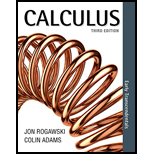
Which of the given differential equations are linear and to determine the order of each equation.
Answer to Problem 1CRE
Solution:
(b) and (d) are linear equations with first and second order respectively while (a) and (c) are non-linear equations with first and third order respectively.
Explanation of Solution
Initially check for linearity. Then observe the higher order derivative to determine the order of the equation.
Given:
(a)
(b)
(c)
(d)
Calculation:
(a) - is a non-linear term, hence this is not a linear equation. This is a first order equation as the first derivative is the highest order derivative here.
(b) - this is a linear equation. This is a first order equation as the first derivative is the highest order derivative here.
(c) - is a non-linear term so this is not a linear equation. This is a third order equation as the third derivative is the highest order derivative here.
(d) - this is a linear equation. This is a second order equation as the second derivative is the highest order derivative here.
Conclusion:
Hence, (b) and (d) are linear equations with first and second order respectively while (a) and (c) are non-linear equations with first and third order respectively.
Want to see more full solutions like this?
Chapter 9 Solutions
Calculus: Early Transcendentals
 Calculus: Early TranscendentalsCalculusISBN:9781285741550Author:James StewartPublisher:Cengage Learning
Calculus: Early TranscendentalsCalculusISBN:9781285741550Author:James StewartPublisher:Cengage Learning Thomas' Calculus (14th Edition)CalculusISBN:9780134438986Author:Joel R. Hass, Christopher E. Heil, Maurice D. WeirPublisher:PEARSON
Thomas' Calculus (14th Edition)CalculusISBN:9780134438986Author:Joel R. Hass, Christopher E. Heil, Maurice D. WeirPublisher:PEARSON Calculus: Early Transcendentals (3rd Edition)CalculusISBN:9780134763644Author:William L. Briggs, Lyle Cochran, Bernard Gillett, Eric SchulzPublisher:PEARSON
Calculus: Early Transcendentals (3rd Edition)CalculusISBN:9780134763644Author:William L. Briggs, Lyle Cochran, Bernard Gillett, Eric SchulzPublisher:PEARSON Calculus: Early TranscendentalsCalculusISBN:9781319050740Author:Jon Rogawski, Colin Adams, Robert FranzosaPublisher:W. H. Freeman
Calculus: Early TranscendentalsCalculusISBN:9781319050740Author:Jon Rogawski, Colin Adams, Robert FranzosaPublisher:W. H. Freeman
 Calculus: Early Transcendental FunctionsCalculusISBN:9781337552516Author:Ron Larson, Bruce H. EdwardsPublisher:Cengage Learning
Calculus: Early Transcendental FunctionsCalculusISBN:9781337552516Author:Ron Larson, Bruce H. EdwardsPublisher:Cengage Learning





